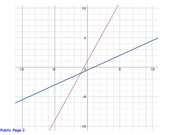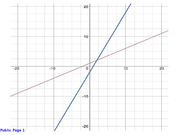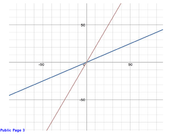If k does not equal -1, 0 or 1, does the point of intersection of line y=kx+b and line x=ky+b have a negative x-coordinate?
(1) kb>0
(2) k>1
OA is C
How this question can be solved graphically.
Sachin
If k does not equal -1, 0 or 1, does the point of intersecti
This topic has expert replies
- sachin_yadav
- Master | Next Rank: 500 Posts
- Posts: 212
- Joined: Mon Dec 06, 2010 12:52 am
- Location: India
- Thanked: 5 times
- Followed by:1 members
- sachin_yadav
- Master | Next Rank: 500 Posts
- Posts: 212
- Joined: Mon Dec 06, 2010 12:52 am
- Location: India
- Thanked: 5 times
- Followed by:1 members
- GMATGuruNY
- GMAT Instructor
- Posts: 15539
- Joined: Tue May 25, 2010 12:04 pm
- Location: New York, NY
- Thanked: 13060 times
- Followed by:1906 members
- GMAT Score:790
Line 1: y = kx + bsachin_yadav wrote:If k does not equal -1, 0 or 1, does the point of intersection of line y=kx+b and line x=ky+b have a negative x-coordinate?
(1) kb>0
(2) k>1
Line 2, rephrased with y isolated: y = (1/k)x - (1/k)b
At the point of intersection, the two lines must have the same y-coordinate, implying that the portions in blue are equal:
kx + b = (1/k)x - (1/k)b
kx - (1/k)x = -b - (1/k)b
Multiplying both sides by k, we get:
k²x - x = -bk - b
x(k² - 1) = -b(k+1)
x(k+1)(k-1) = -b(k+1)
x(k-1) = -b
x = -b/(k-1)
The value of x will be negative if b and k-1 have the SAME SIGN.
Question stem, rephrased:
Do b and k-1 have the same sign?
Statement 1:
Case 1: b=1 and k=2, implying that k-1 = 2-1 = 1.
In this case, b and k-1 have the same sign.
Case 2: b=1 and k=1/2, implying that k-1 = 1/2 - 1 = -1/2.
In this case, b and k-1 have different signs.
Since the answer is YES in Case 1 but NO in Case 2, INSUFFICIENT.
Statement 2:
Since k>1, k-1 > 0.
No information about b.
INSUFFICIENT.
Statements combined:
Since bk>0 and k>1, b>0.
Since k>1, k-1>0.
Thus, b and k-1 have the same sign.
SUFFICIENT.
The correct answer is C.
Private tutor exclusively for the GMAT and GRE, with over 20 years of experience.
Followed here and elsewhere by over 1900 test-takers.
I have worked with students based in the US, Australia, Taiwan, China, Tajikistan, Kuwait, Saudi Arabia -- a long list of countries.
My students have been admitted to HBS, CBS, Tuck, Yale, Stern, Fuqua -- a long list of top programs.
As a tutor, I don't simply teach you how I would approach problems.
I unlock the best way for YOU to solve problems.
For more information, please email me (Mitch Hunt) at [email protected].
Student Review #1
Student Review #2
Student Review #3
Followed here and elsewhere by over 1900 test-takers.
I have worked with students based in the US, Australia, Taiwan, China, Tajikistan, Kuwait, Saudi Arabia -- a long list of countries.
My students have been admitted to HBS, CBS, Tuck, Yale, Stern, Fuqua -- a long list of top programs.
As a tutor, I don't simply teach you how I would approach problems.
I unlock the best way for YOU to solve problems.
For more information, please email me (Mitch Hunt) at [email protected].
Student Review #1
Student Review #2
Student Review #3
- sachin_yadav
- Master | Next Rank: 500 Posts
- Posts: 212
- Joined: Mon Dec 06, 2010 12:52 am
- Location: India
- Thanked: 5 times
- Followed by:1 members
Mitch,
Thanks for your explanation. I have understood to what you have just explained algebraically; However i am more looking for a graphical solution. I don't have any simulation otherwise i would have made the graph and uploaded it. So that i can ask you where i am making the mistake. The graph that i am making is giving me OA E, which is wrong.
Also, how should i decide whether to solve graphically or algebraically.
Regards
Sachin
Thanks for your explanation. I have understood to what you have just explained algebraically; However i am more looking for a graphical solution. I don't have any simulation otherwise i would have made the graph and uploaded it. So that i can ask you where i am making the mistake. The graph that i am making is giving me OA E, which is wrong.
Also, how should i decide whether to solve graphically or algebraically.
Regards
Sachin
Never surrender
- GMATGuruNY
- GMAT Instructor
- Posts: 15539
- Joined: Tue May 25, 2010 12:04 pm
- Location: New York, NY
- Thanked: 13060 times
- Followed by:1906 members
- GMAT Score:790
One way to plot a line:sachin_yadav wrote:If k does not equal -1, 0 or 1, does the point of intersection of line y=kx+b and line x=ky+b have a negative x-coordinate?
(1) kb>0
(2) k>1
1. Determine the y-intercept by plugging in x=0 and solving for y
2. Determine the x-intercept by plugging in y=0 and solving for x
3. Draw a line through the two intercepts
Statement 1: kb > 0
Test one case that also satisfies Statement 2.
Case 1: k=2, b=1
Here, the two lines are y=2x+1 and x=2y+1.
The following graph is yielded:

Test one case that does NOT also satisfy Statement 2.
Case 2: k=1/2, b=1
Here, the two lines are y= (1/2)x + 1 and x = (1/2)y + 1.
The following graph is yielded:

Since the point of intersection has a negative x-coordinate in Case 1 but a nonnegative x-intercept in Case 2, INSUFFICIENT.
Statement 2: k>1
Case 1 also satisfies Statement 2.
Case 3: k=2, b=0
Here, the two lines are y=2x and x=2y.
The following graph is yielded:

Since the point of intersection has a negative x-coordinate in Case 1 but a nonnegative x-intercept in Case 3, INSUFFICIENT.
Statements combined:
Case 1 satisfies both statements.
Case 4: k=5, b=10
Here, the two lines are y=5x+10 and x=5y+10.
The following graph is yielded:

Cases 1 and 4 illustrate that -- if kb>0 and k>1 -- the point of intersection must have a negative x-coordinate.
SUFFICIENT.
The correct answer is C.
Private tutor exclusively for the GMAT and GRE, with over 20 years of experience.
Followed here and elsewhere by over 1900 test-takers.
I have worked with students based in the US, Australia, Taiwan, China, Tajikistan, Kuwait, Saudi Arabia -- a long list of countries.
My students have been admitted to HBS, CBS, Tuck, Yale, Stern, Fuqua -- a long list of top programs.
As a tutor, I don't simply teach you how I would approach problems.
I unlock the best way for YOU to solve problems.
For more information, please email me (Mitch Hunt) at [email protected].
Student Review #1
Student Review #2
Student Review #3
Followed here and elsewhere by over 1900 test-takers.
I have worked with students based in the US, Australia, Taiwan, China, Tajikistan, Kuwait, Saudi Arabia -- a long list of countries.
My students have been admitted to HBS, CBS, Tuck, Yale, Stern, Fuqua -- a long list of top programs.
As a tutor, I don't simply teach you how I would approach problems.
I unlock the best way for YOU to solve problems.
For more information, please email me (Mitch Hunt) at [email protected].
Student Review #1
Student Review #2
Student Review #3



















